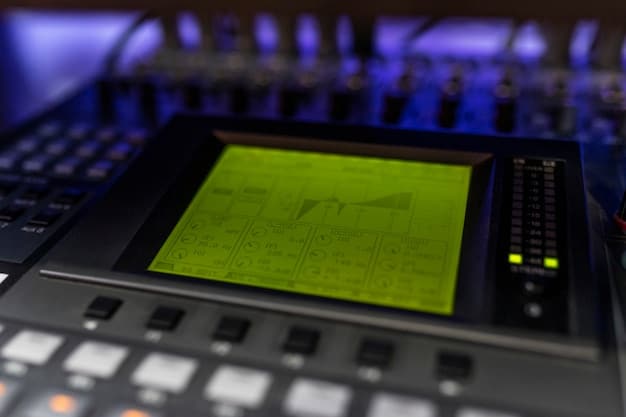The Future of Movie Soundtracks: New Licensing Agreements Impact US Films in 2025

The Future of Movie Soundtracks: How New Music Licensing Agreements Will Affect US Films in 2025 involves a shift in how music is licensed for movies, potentially influencing the creative choices of filmmakers and the financial landscape for both studios and musicians.
The cinematic experience is as much about sound as it is about visuals, and the music that scores our favorite films plays a crucial role in drawing us into the story. As we look ahead to 2025, the future of movie soundtracks: how new music licensing agreements will affect US films is a hot topic, promising to reshape the industry.
The Evolving Landscape of Music Licensing
The way music is used in movies is changing. New technologies and shifts in the music industry are impacting how licensing agreements are structured. This evolution affects everyone, from studios to independent filmmakers.
Understanding these changes is critical for anyone involved in the film industry. Let’s dive into the key aspects of this evolving landscape:
Digital Distribution and Streaming
The rise of digital distribution and streaming platforms has revolutionized how music is consumed. This shift has huge implications for movie soundtracks, as filmmakers now have access to a wider range of music than ever before.
Negotiating Licensing Agreements
Negotiating music licensing agreements can be a complex process. With numerous stakeholders involved, it’s essential to understand the rights and royalties associated with using music in films.
- Understand the Different Types of Licenses: Synchronization, master use, and performance licenses each cover different aspects of music usage.
- Negotiate Upfront Fees and Royalties: Clear agreements on costs and revenue sharing are vital for budgeting and financial planning.
- Consider the Scope of Use: Agreements must clearly define how the music will be used, including territories, platforms, and duration.
Ultimately, the evolving landscape of music licensing presents both challenges and opportunities for the US film industry in 2025.

Key Players in Music Licensing
Music licensing involves several key players, each with distinct roles and responsibilities. Understanding these roles helps in navigating the complex process of securing music rights for films.
These players include music publishers, performing rights organizations (PROs), and individual artists. Each has a significant impact on the soundtracks we hear. Let’s explore their roles:
Music Publishers
Music publishers represent songwriters and composers, managing their copyrights and licensing their music. They play a crucial role in negotiating deals for the use of music in films.
Performing Rights Organizations (PROs)
PROs, such as ASCAP, BMI, and SESAC, collect performance royalties on behalf of songwriters and publishers. These royalties are generated when music is publicly performed, including in movie theaters and on streaming platforms.
- ASCAP: Stands for American Society of Composers, Authors and Publishers.
- BMI: Broadcast Music, Inc.
- SESAC: Originally the Society of European Stage Authors and Composers
Understanding the roles of these key players is essential for filmmakers looking to navigate the music licensing landscape effectively in 2025 and beyond. The relationships between these entities will continue to evolve.
How New Agreements Will Affect Filmmakers
New music licensing agreements are poised to have a significant impact on filmmakers, affecting creative choices, budget considerations, and overall production processes.
Filmmakers need to stay informed about these changes to adapt and maintain a competitive edge. Here’s how these agreements will affect them:
Creative and Artistic Choices
Licensing costs can influence the music choices filmmakers make. Budget constraints may lead to the selection of lesser-known tracks or original compositions over popular hits.
Budgetary Implications
Music licensing fees can represent a substantial portion of a film’s budget. Negotiating favorable terms becomes crucial for managing costs effectively.
Production Process
The complexities of music licensing can add time and administrative burden to the production process. Streamlining these processes can help filmmakers stay on schedule and within budget.
The new music licensing agreements of 2025 will require filmmakers to be more strategic and informed in their approach to music selection and licensing.
The Impact on Independent Films
Independent films often face unique challenges when it comes to music licensing. With limited budgets and resources, securing the rights to use music can be particularly difficult.
Creative solutions and alternative licensing models are crucial for indie filmmakers. Let’s look at the specific challenges and opportunities:

Challenges in Affording Music Licenses
The high cost of music licenses can be prohibitive for independent filmmakers. Finding affordable options without compromising creative vision is a constant struggle.
Creative Solutions and Alternatives
Independent filmmakers often turn to creative solutions, such as using original music, collaborating with emerging artists, or exploring alternative licensing models.
Opportunities for Emerging Artists
Featuring music from emerging artists can provide mutual benefits. Filmmakers gain access to affordable music, while artists gain exposure to a wider audience.
The evolving music licensing landscape presents both obstacles and opportunities for independent films in 2025, requiring resourcefulness and a strategic approach.
The Role of Technology in Licensing
Technology is playing an increasingly significant role in music licensing, from facilitating the discovery of music to streamlining the licensing process itself.
Digital platforms and AI-driven tools are transforming how filmmakers find and license music. Here’s how:
Digital Platforms for Music Discovery
Online platforms, such as music streaming services and specialized licensing marketplaces, make it easier than ever for filmmakers to discover new music and connect with rights holders.
AI-Driven Music Licensing Tools
Artificial intelligence (AI) is being used to analyze music attributes, match songs to scenes, and automate the licensing process, saving time and resources.
Blockchain and Smart Contracts
Blockchain technology and smart contracts offer the potential to create more transparent and efficient music licensing systems, ensuring that rights holders are properly compensated.
As technology continues to advance, it will further revolutionize music licensing, making it more accessible and efficient for filmmakers in the years to come.
Future Trends and Predictions
Looking ahead to 2025 and beyond, several key trends are expected to shape the future of music licensing in the US film industry. These trends will impact how movies are made and enjoyed.
From new licensing models to evolving artist compensation, here are some predictions:
New Licensing Models
Subscription-based licensing models and blanket licenses may become more prevalent, offering filmmakers more flexible and cost-effective options.
Evolving Artist Compensation
Efforts to ensure fair compensation for artists will continue to drive changes in licensing agreements, including increased royalty rates and greater transparency.
Globalization of Music
The increasing globalization of music will lead to more cross-border collaborations and licensing agreements, requiring filmmakers to navigate international copyright laws.
| Key Point | Brief Description |
|---|---|
| 🎵 Music Licensing Evolution | Digital platforms are changing how music is licensed in films. |
| 🎬 Impact on Filmmakers | New agreements affect budget, creative choices, and production processes. |
| 💵 Challenges for Indie Films | Securing music rights is difficult due to limited budgets. |
| 🤖 Tech in Licensing | AI and blockchain streamline music licensing, improving efficiency. |
FAQ
▼
The main types include synchronization licenses (for using music in visual media), master use licenses (for using a specific recording), and performance licenses (for public performances). Each covers different rights and requires separate negotiations.
▼
New agreements can strain indie filmmakers’ budgets, forcing them to seek creative solutions like using original music or collaborating with emerging artists. This fosters innovation but also presents financial hurdles.
▼
PROs (like ASCAP, BMI, SESAC) collect performance royalties on behalf of songwriters and publishers when music is publicly performed. They ensure artists are compensated when their work is used in films and broadcasts.
▼
Technology streamlines music discovery and licensing. AI tools match songs to scenes, while blockchain improves transparency in royalty payments. Digital platforms also connect filmmakers with rights holders efficiently.
▼
Future trends include subscription licensing models, increased artist compensation, and globalization of music. These trends will likely lead to more flexible and equitable licensing agreements in the film industry.
Conclusion
As we look forward to 2025, the future of movie soundtracks: how new music licensing agreements will affect US films, it’s clear that changes are on the horizon. Filmmakers, music publishers, and artists alike must stay informed and adaptable to navigate the evolving landscape effectively.



![Special Effects Secrets: Making [Movie Title] Magic for Under $50K Special Effects Secrets: Making [Movie Title] Magic for Under $50K - Cover Image](https://endingnew.com/wp-content/uploads/2025/06/endingnew.com_13_1749558769_a0223f59_cover-360x180.jpg)

